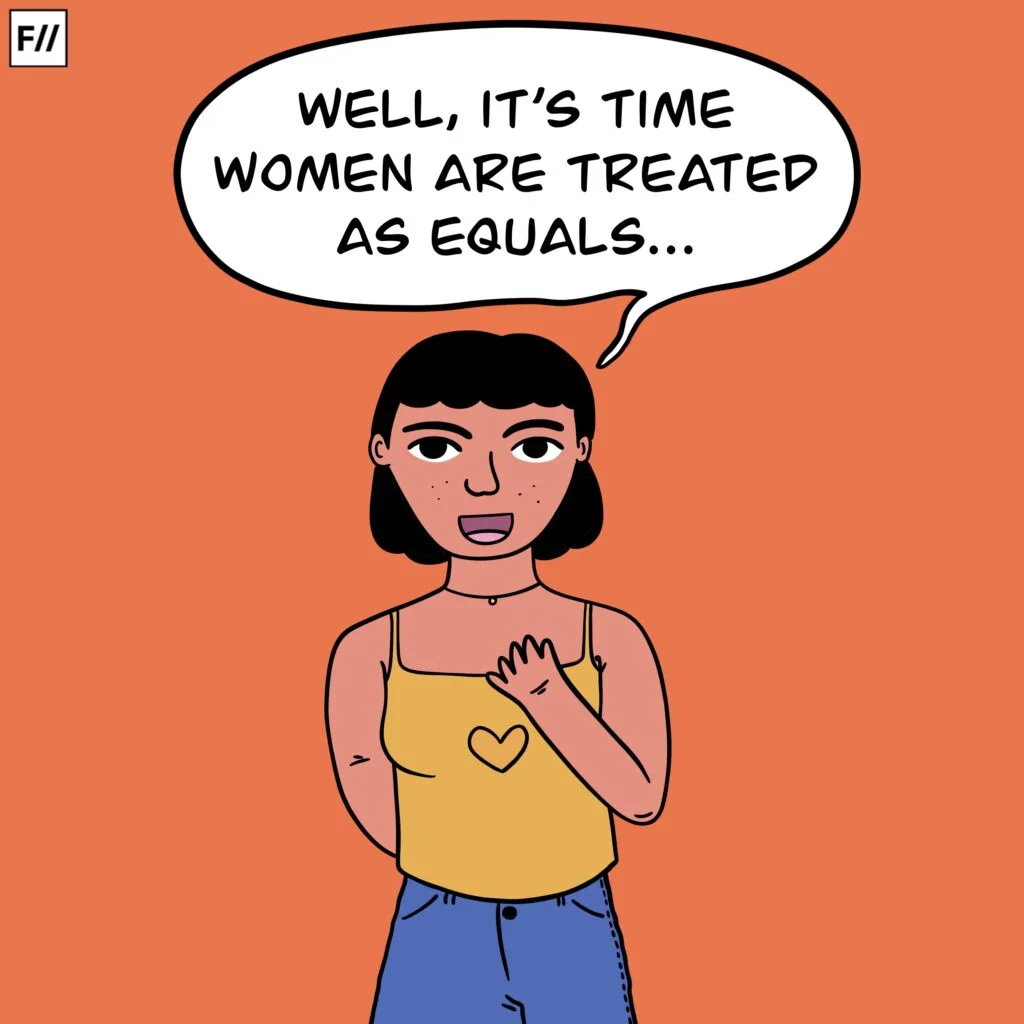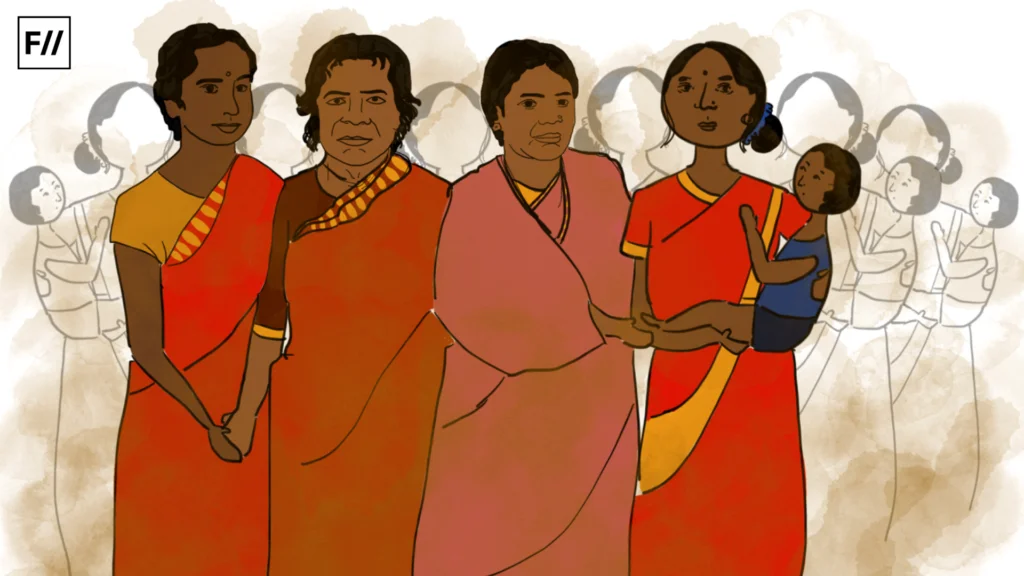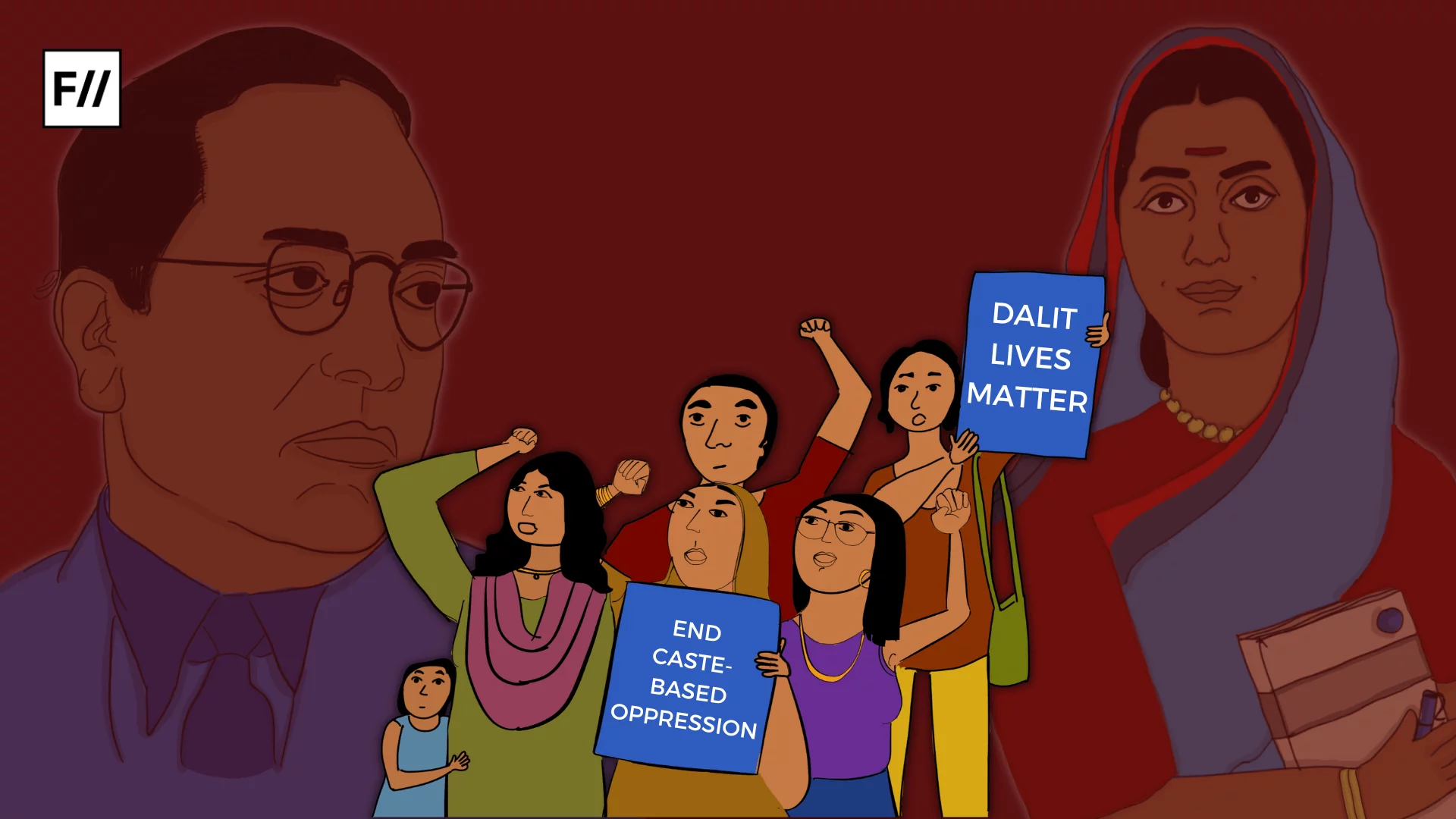In India, caste is a highly contested and widely discussed topic. Some interpret it through the intersection of caste and labour, while others interpret it through caste and class. However, one pairing that was misrecognised from independence to the 1990s is the intersection of caste and gender or the intertwining of Brahminism and patriarchy. The visibility of this intersectionality draws inspiration from the Black Feminism of the West, where there was a hegemonised discourse of white middle-class women claiming to serve all women. Similarly, India saw the emergence of Dalit feminism.
Before understanding Dalit feminism and its emergence, it’s crucial to understand the political and historical context of the 1990s. During this time, there was agitation against OBC reservation by middle-class college students. The 1990s marked a decade characterised by a push for identity, often considered the “decade for identity politics.” Tharu and Niranjana, in their article “The Problem for a Contemporary Theory of Gender,” note that “In the 1990s, women were everywhere, whether taking part in the anti-Mandal agitation or participating in the procession of the Rath Yatra.” Therefore, this visibility needs to be contextualised within the larger socio-cultural milieu and the rights of women. These agitations reveal the politics of dominance and the contradictions of gender, caste, and class composition.
In the Anti-Mandal agitation, upper-caste and middle-class women were seen holding banners with slogans like “WE WANT EMPLOYED HUSBANDS.” This particular slogan indicates that these women were not going to marry OBC and SC men because, due to reservation, upper-caste and middle-caste men would not get jobs, which are considered their future husbands. This indicates the notion of endogamy.
Additionally, these women did not consider themselves competitors because they believed it was only their future husbands who were going to compete. They also did not consider the benefits that OBC women would receive from the reservation, mentions Tharu & Niranjana,1994. This incident reveals the limited notion of sisterhood and the fact that women from homogenised categories do not necessarily share the same interests. This anomaly among women leads the discourse of difference with feminist discourse.
Amidst the significant political events such as the Babri Masjid demolition and the liberalisation of the economy, there was also a politics of difference emerging within the women’s movement. This politics of difference stemmed from the misrecognition and ignorance of the needs and demands of women who did not share the same public space, and social, and cultural capital as those leading the mainstream women’s movement.

One counter-discourse that emerged from this was Dalit feminism, which focused on the experiences and struggles of women who were on the margins of society. Dalit feminism is a movement that focuses on the historical struggles and lived experiences of Dalit women. It recognises how the position of Dalit women in Indian society – is “triply oppressed” because of their class, caste, and gender positionality which is critical to understanding power configurations in India’s society, economy, politics, and culture.
Dalit feminism aligns with the perspective of black feminist Bell Hooks, who argues that marginalised individuals, not invested in society’s privileges, are more in touch with social reality. Similarly, Dalit Feminism critiques radical and liberal feminism for primarily addressing issues faced by upper and middle caste and class women, advocating instead for a feminism that addresses the specific struggles of Dalit women.
Question of caste in women’s movement
In India, the women’s movement of the 1970s primarily involved urban, upper-caste women from economically privileged backgrounds who had strong ties to communist and radical left politics. In contrast, Dalit feminists chose to write using auto-ethnography, which not only details their struggles but also shows the societal constraints that hinder their pursuit of their desires.
Dalit feminists often write in their regional languages, translated into English and Hindi to reach a wider audience. This translation from regional to standardised languages plays a crucial role in spreading the discourse of difference within the mainstream women’s movement.

For example, “Karukku: An Autobiography” by Bama, originally written in Tamil, was translated into English. Another example is “The Prison We Broke” by Babytai Kamble, originally written in Marathi. These translations make the experiences and perspectives of Dalit women accessible to a wider audience, contributing to a more inclusive feminist discourse.
The Dalit feminist Samita M. Patil argues that Dalit feminism can strengthen its ideological foundation by examining how the dominant Brahmanical culture influences both left-wing movements and feminist critiques. This examination is crucial in understanding how these movements might appropriate the knowledge produced by Dalit critiques, including Dalit feminist perspectives.
Many Dalit feminist thinkers and scholars have extensively written about the cause of Dalit women. For example, Sharmila Rege argues that women’s organisations collapsed caste into class and sisterhood, moving a “Savarnisation of womanhood.” Meena Gopal argues that feminist organisations have failed to problematise the location of Dalit women and their autonomy within the feminist movement. Gail Omvedt argues that the caste system is based on graded inequalities, with individuals being both oppressors and oppressed simultaneously.
Women of each caste are marginalised, but Dalit women are at the bottom of the hierarchy, making them the most downtrodden. To move this struggle of difference, Gopal Guru calls it “Dalit women Talking differently.”
Question of Gender in Dalit Movement
When we look at the mainstream Dalit movement, there is a tendency to equalise all Dalit experiences with those of Dalit men. Dalit feminism is not only striving to carve out a space within the mainstream women’s movement but also working to transform and critique the Dalit movement itself. The masculinisation of Dalithood within the movement, for example, often portrays Dalit women as mothers and victimised sexual beings rather the being with political agency. Within this framework, Dalit men’s assertion of manhood comes from asserting control over the sexuality of Dalit women, seen as a symbol of this assertion.

For instance, leaders like John Pandiyan in Meenakshi Purum reportedly encourage Harijans to seek brides from outside their community and, if necessary, abduct them if an agreement cannot be reached, as mentioned by Gabriele Dietrich in her article “Dalit Movement and Women’s Movements.” While this action is framed as a means to achieve social equality, it inadvertently reinforces Brahminical ideas of prioritising marriage with upper castes. As a result, it perpetuates regressive and patriarchal norms that harm women as a whole, rather than contributing to the dissolution of caste distinctions.
Role of Dalit Women Organisations
In the 1990s, the concept of Gendered Dalit Politics of Difference emerged through organisations like the National Federation of Dalit Women. These autonomous groups emphasised that the oppression faced by Dalit women is distinct and cannot be equated with the experiences of upper-caste women. They highlighted the necessity for fair representation that accounts for the specific challenges encountered by Dalit women within the broader framework of gendered politics.

Dalit Social organisations played an important role in making space for Dalit feminism. In 2005, when the government of Maharashtra state announced a ban on women performing in dance bars, there was a rift between activists supporting and opposing the ban. The All-India Democratic Women’s Association, affiliated with the Communist Party of India (Marxist), and Dalit-Bahujan feminist groups have divergent stands on the ban. Dalit-Bahujan activists expressed anger and hurt, arguing that support for bar dancers, even in the name of protecting livelihoods, reinforced caste-based sexual exploitation of lowered-caste women.
Conversely, the earlier organisation opposed the ban because it infringed upon the bar dancers’ right to livelihood. The Dalit organisation highlighted how caste intertwines with sexuality and labour, perpetuating and reinforcing caste prejudices. Women from lowered-castes, such as the Bedia community, are often forced into these caste-based occupations due to their caste status.
The emergence and reflection of marginalised women’s voices in the mainstream feminist movement have led to the development of Dalit feminism, which seeks to understand multiple marginalities and promote dialogue across differences. In the 1990s, Dalit feminists asserted their identity independently and autonomously by naming their differences. This assertion was a form of dissent against both the mainstream women’s movement and the male-dominated Dalit movement.
References:
- Arya, S., & Rathore, A. S. (Eds.). (2020). Dalit feminist theory: A reader. Routledge, Taylor & Francis Group.
- Chakravarti, U. (1993). Conceptualising Brahmanical Patriarchy in Early India.
- Gopal, M. (2012). Caste, sexuality and labour: The troubled connection. Current Sociology, 60(2), 222–238. https://doi.org/10.1177/0011392111429223
- Gupta, C. (2010). Feminine, criminal or manly?: Imaging Dalit masculinities in colonial north India. The Indian Economic & Social History Review, 47(3), 309–342. https://doi.org/10.1177/001946461004700302
- Guru, G. (2019). Dalit women talk differently 1. In S. Arya & A. S. Rathore (Eds.), Dalit Feminist Theory (1st ed., pp. 150–153). Routledge India. https://doi.org/10.4324/9780429298110-16
- (Issues in Contemporary Indian Feminism) Anupama Rao (ed.)—Gender and Caste-Zed Books (2005).pdf. (n.d.).
- Rage. (1998). Dalit Women Talk Differently: A Critique of “Difference” and Towards a Dalit Feminist Standpoint Position.
- Tharu, S., & Niranjana, T. (1994). Problems for a Contemporary Theory of Gender. Social Scientist, 22(3/4), 93–117. https://doi.org/10.2307/3517624





